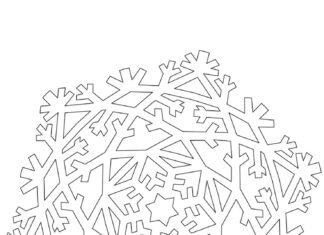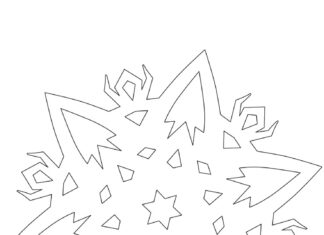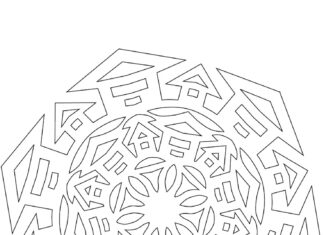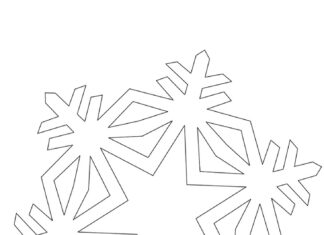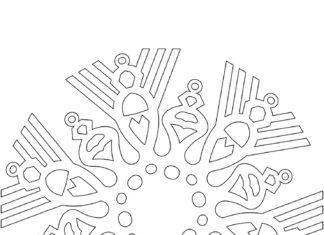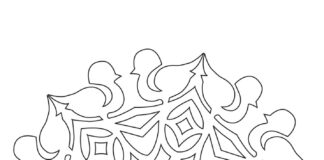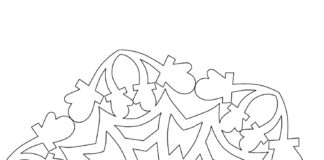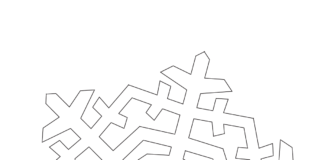Snowflakes are small ice crystals that form in clouds when moist air turns directly into ice. Each snowflake is unique and has an individual, often symmetrical shape, resulting from the various atmospheric conditions during its formation. Traditionally, it is said that no two snowflakes are identical. These flakes combine to form a snow cover on the ground.
Snowflake coloring pages
Information
- Process of formation: Snowflakes are formed when moist air in clouds freezes to form ice crystals. The process begins with a microscopic grain of dust or other nuclear agent, around which ice begins to form.
- Shapes: There are different shapes of snowflakes, depending on the temperature and humidity levels during their formation. The basic forms include needles, columns, plates and dendrites.
- Uniqueness: Although it is difficult to prove that no two snowflakes are identical, the variety of conditions during snowflake formation makes the probability of two exactly identical snowflakes extremely small.
- Symmetry: Many snowflakes have a hexagonal, radial symmetry. This is a result of the shape of the ice crystal and the way it grows.
- Petal study: Wilson Bentley was the first scientist to photograph a single snowflake in 1885. This led to a more in-depth study of their structure and diversity.
- Application in science: Snowflakes have been used to study crystals, leading to discoveries in crystallography.
- Weather conditions: Snowflakes can only form under certain atmospheric conditions. In air that is too dry or at too low a temperature, only ice crystals can form, not typical flakes.
- Snowflakes in Culture: Snowflakes are a frequent motif in art, literature and culture, symbolizing winter, fragility and uniqueness.
- Impact on the ecosystem: The snowpack, formed from millions of snowflakes, plays an important role in the ecosystem by insulating the land, providing water as it melts and influencing the climate of a region.
- Descent rate: Snowflakes fall at different speeds depending on their size, shape and weather conditions. On average, they fall at a speed of 1 to 6 cm/sec.
Trivia
- Uniqueness: Although it is often heard that no two snowflakes are identical, it is theoretically possible that two identical snowflakes could form under identical conditions. However, due to the huge variety of conditions, this probability is negligible.
- Hexagonal Symmetry: Most snowflakes have hexagonal symmetry, which is due to the molecular arrangement of ice. Water freezes in hexagonal structures to form symmetrical shapes.
- First Photo: Wilson Bentley was the first to photograph a snowflake in 1885. He used a specially constructed microscope and took more than 5,000 pictures of snowflakes.
- Strongest Snow: A type of snow has been discovered in Antarctica that could be the hardest in the world. The snowflakes in the area were as hard as steel.
- Record Snowflakes: The largest documented snowflakes were 15 inches in diameter (38 cm) and fell in Fort Keogh, Montana, USA, in 1887.
- Snow in the Desert: Snowflakes can fall even in the desert. For example, snow fell in the Sahara in 1979, and it happens in other dry areas of the world, too.
- Arrangement of Crystals: Research on snowflakes has led to discoveries in crystallography and materials science, influencing the development of technology.
- Snow and Sound: The snow cover, created from snowflakes, can affect sound in the environment, muffling it and creating quieter conditions.
- Snow and Climate: Snowflakes and snow cover affect the climate by reflecting the sun's rays and affecting the temperature.
- Snowflake Color: Snowflakes are transparent, but appear white. This is due to the fact that light reflects off the many surfaces of the crystals, scattering in all directions.

